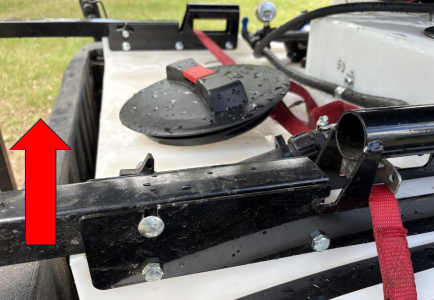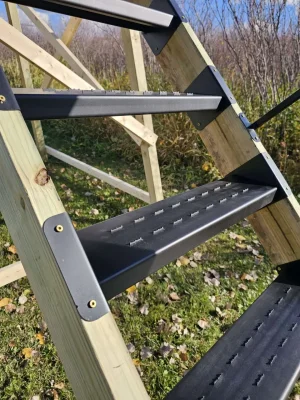Turkey Creek
5 year old buck +
My favorite frog by far, unless someone is frying frog legs and then those are! LOLSome rain and everyone rejoices! (I suspect this is as joyful as a tree frog gets)
View attachment 77771View attachment 77772
My favorite frog by far, unless someone is frying frog legs and then those are! LOLSome rain and everyone rejoices! (I suspect this is as joyful as a tree frog gets)
View attachment 77771View attachment 77772
Ya, they are way cool!My favorite frog by far, unless someone is frying frog legs and then those are! LOL
Thanks for posting! Mine is set up like yours. The question I have is that if you loosen up the knobs, does it rotate upwards (see arrow)? The slots make me think it should, but mine won't budge.Going to dump some photos here in order to provide some info for one of the members that has a similar sprayer to mine......and wants to see how my boom mounts. Pics are below. (shoot the best pic was taken as a movie. Maybe more pics tommorow. Sorry. Hope this helps.
I should take a file to those slots shown the are on the right (front). They are very hard to get those "ears" started, I have to tap em with a hammer and have everything aligned correctly which is a bit problematic. But then they go.
This sprayer (Master Mfg 50 gallon UTV Sprayer - boomless) really fits my Honda Pioneer 700-4 very well. Like perfect. I can spray about 3 acres on a full tank....at 4 mph. Some variables depending which nozzles I use. Neat part is you can pick and choose pattern width by altering nozzle positions at the drop of a hat. Usually I make several changes over the tank full. Nice feature.
View attachment 77761
View attachment 77766

The issue on mine, is that the square tubing right underneath the pivot pins dig into the tank if I try to rotate upwards. I may have to get the grinder out and round off the bottom of those tubes.Yes. Mine does. But I do believe it’s all a bit too tight of a fit. A little file work should solve that. I do have to force things a bit to fit.
To me, I think those slots could have some taper to them and not defeat the intent….as long as the bottom of the slot is retained.
You likely have a good solution. Mine has not been bad enough to mess with yet. But it’s on the list. A little radius on that tube might be a great solution.The issue on mine, is that the square tubing right underneath the pivot pins dig into the tank if I try to rotate upwards. I may have to get the grinder out and round off the bottom of those tubes.
keep moving: mentally and physicallyBoost Your Knowledge! DID YOU KNOW?
Birds do not urinate.
Horses and cows sleep while standing.
The bat is the only mammal capable of flight. Its leg bones are so thin that it cannot walk.
Even when a snake’s eyes are closed, it can still see through its eyelids.
Despite their fluffy white fur, Polar Bears actually have black skin.
The average housefly lives only 2 to 3 weeks.
For every human, there are approximately one million ants.
A small amount of alcohol on a scorpion will drive it insane and cause it to sting itself to death.
Alligators and sharks can live for up to 100 years.
A honeybee has two stomachs: one for honey and one for food.
Elephants weigh less than the tongue of a blue whale. A blue whale’s heart is the size of a car.
Blue whales are the largest creatures to ever roam the Earth.
A cockroach can survive for about a week without its head before dying of starvation.
When a dolphin is sick or injured, its cries of distress prompt other dolphins to assist, helping it surface to breathe.
A snail can sleep for up to 3 years.
The fastest bird, the spine-tailed swift, can fly at speeds of up to 106 mph. (The peregrine falcon is even faster at 390 km/h or 108 mph.)
A cow produces nearly 200,000 glasses of milk in her lifetime.
The leech has 32 brains.
The average outdoor cat lives only 3 years, while indoor-only cats can live 16 years or longer.
Sharks are immune to every disease, including cancer.
A mosquito’s proboscis has 47 sharp edges to help it cut through skin and even protective clothing.
The human brain has a memory capacity of over 2.5 million petabytes, equivalent to 2,500,500 gigabytes.
Knowledge is Power!
What is the biological phenomenon responsible for the gradual loss of muscle mass, strength, and function as we age? This is known as Sarcopenia!
Sarcopenia refers to the progressive loss of skeletal muscle mass and strength due to aging. The impact of this condition can be severe, depending on the individual.
How to prevent Sarcopenia?
Stay Active: If you can stand, don’t sit—if you can sit, don’t lie down! Movement is key to preventing muscle loss.
Encourage Movement in the Elderly: When an elderly person is sick or hospitalized, avoid encouraging them to rest or remain in bed. Help them walk, unless they are too weak to do so. Lying in bed for just a week can cause a 5% loss in muscle mass, and seniors often cannot fully recover this loss.
Sarcopenia is more concerning than osteoporosis: With osteoporosis, the primary risk is falling, but sarcopenia not only affects quality of life but also contributes to high blood sugar due to reduced muscle mass.
Idle muscles lead to faster muscle loss: Muscles in the legs deteriorate quickly when not used. Sitting or lying down limits leg movement, weakening muscles. Activities like walking, running, and cycling are excellent ways to build and maintain muscle mass.
Aging Starts from the Feet Up! Keep your legs active and strong as you age. If you don’t move your legs for just two weeks, you’ll lose the strength of a decade! Regular exercises like walking and cycling are vital for maintaining muscle strength.
The feet support the entire body’s weight, making them critical for mobility. So, walk every day to maintain strength and mobility.
Credit goes to respective owner
Killed my first deer out of a homemade stand.View attachment 78160
Sat on a 5 gallon pail and tied myself to the tree with a rope around my waist. Lol. A wonder we never died doing these things.
 www.facebook.com
www.facebook.com


 fabtechmfg.net
fabtechmfg.net
What do those cost? They look pretty sweet.So, I am buying nine of these Fab Tech stair treads to use with my new blind. I am making an 8 foot high wooden tower out of treated wood....but thought I would try a set of these steps....as I like the design idea and want to try em. So, I call to order them.....and they have a total of "one" stair tread on hand. (smile). That is no way to run a biz of specialty parts like this.
View attachment 78361

DEER STAND STAIR TREADS KIT - FabTech Manufacturing
fabtechmfg.net
I'm a little on the fence with these treads. I also wonder how slip resistant they are as compared to a treated wood tread. Dunno, but the guy I spoke with said they were really good. They cost $25 per tread.....and I need 9 of them......so it does add up to perhaps double the price of a wood system. Still I like easy and reliable solutions. If they are not able to ship very soon.....I will build 'em out of wood because I don't want to build stuff when it gets hot later in summer.....and I get impatient.What do those cost? They look pretty sweet.
yeah.....I wonder if those stair treads could be "stamped" as a unit. I've seen some auto ramps that are formed to shape as well as other products formed from stamping dies. Someone in the metal forming biz could "punch" these out.....and put the grip into the treads at the same time. Kaching. grin.That’s a shame. Those treads do look sweet. That handrail looks like it would collapse instantly under any pressure though…
Sent from my iPhone using Tapatalk
